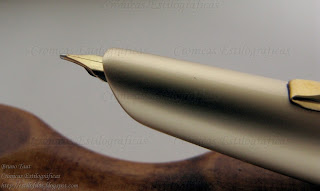After the war, the availability of gold was slowly increasing and some luxury pens were equipped with nibs made of this noble metal. However, many a company played the trick of confusion between gold plated and actual solid gold nibs. The official response came from the almighty Ministry of Industry (actually, the Ministry of International Trade and Industry, MITI): The Industrial Standardization Law was enacted in 1949 and by 1954 the Japan Industrial Standards, JIS, logo imprinted on nibs guaranteed the material out of which they were made.
Platinum (Platinum Sangyo Co. Ltd. at the time), on its side, created the 10 year guaranteed nib in 1953 after perfecting the manufacturing process. Let us remember now that the main argument for the use of gold over steel is the much higher resistance to corrosion of the noble metal.
Platinum Honest 60, on the left, and Presidente pens, on the right, disassembled.
 On the left, the Platinum Honest 60 nib. On the right, that of the Presidente. Both are identical "10 Years" nibs save for the obvious gold plating of the later.
On the left, the Platinum Honest 60 nib. On the right, that of the Presidente. Both are identical "10 Years" nibs save for the obvious gold plating of the later.On these chronicles, paradoxically, the first encounter with a 10 year nib by the hand of the nominally Spanish pen Presidente. Of course, we now know that it was a variation of the Platinum Honest, whose nib, we could also see, was also engraved with the "10 years" sign. But these are not the only examples. 10-year nibs were made in a number of shapes and sizes, and these are some examples.
These nibs belong to an aerometric Honest (left), to a copy of the Parker 51 (center) and to an oversized luxury lever filler (right).
From left to right on the previous picture:
--Nail shaped nib for an aerometric Honest pen.
--Hooded nib. The pen is basically a copy of the Parker 51.
--Big size 20 open nib. It belongs to a luxury lever-filler pen.
These are the pens of the previous nibs. From top to bottom, the oversizez lever filler with the size 20 nib, the copy of the Parker 51, and the aerometric Honest pen.
Platinum 10 Years, copy of Parker 51 – Sailor Sei-boku
Bruno Taut
May 13th, 2012
etiquetas: Platinum, Presidente, Japón, plumín
Bruno Taut
May 13th, 2012
etiquetas: Platinum, Presidente, Japón, plumín































































